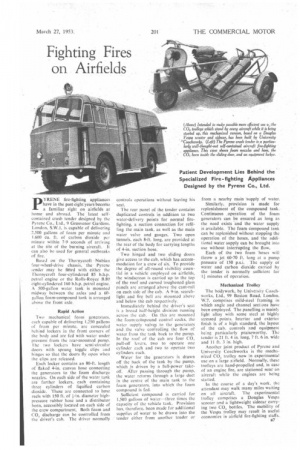Fighting Fires on Airfields
Page 41

If you've noticed an error in this article please click here to report it so we can fix it.
pYRENE fire-fighting appliances have in the past eight yearibecome a familiar sight on airfields at homeand abroad. The latest selfcontained crash tender designed by the Pyrene Co., Ltd., 9 Grosvenor Gardens. London, SW 1, is capable of delivering 2,500 gallons of foam per minute and 1.600 cu. ft. of carbon dioxide per minute within 7-9 seconds of arriving at the site of the burning aircraft. It can also be-used for general outbreaks of fire.
Based on the Thornycroft Nubian f:our-wheel-drive chassis, the Pyrene tender may be fitted with either the Thornycroft four-cylindered 8$ b.h.p. petrol engine or the Rolls-Royce B.80 cight-cylindered 160 b.h.p. petrol engine. A 500-gallon water tank is mounted midway between the axles and a 60gallon foam-compound lank is arranged above the front axle.
Rapid Action
Two mechanical foam generators, each capable of delivering 1,250 gallons of foam per minute, arc concealed behind lockers in the front corners of the body and are fed with water under pressure from the rear-mounted pump. The two lockers have semi-circular doors with sprung toggle clips and hinges so that the doors fly open whets the clips are released.
Each locker contains an 80-ft. length of flaked 4-in, canvas hose connecting the generators to the foam discharge nozzles. On each side of the water tank are further lockers, each containing three cylinders of liquified carbon dioxide. These are connected to hose
reels with 150 ft. of diameter highpressure rubber hose and a distributor horn, accessibly located on each side of the crew compartment. Both foam and CO, discharge can be controlled from the driver's eats. The driver normally
controls operations without leaving his seat_ The rear panel of the tender contains duplicated controls in addition to two water-delivery points for normal firefighting, a suction connection for refilling the main tank, as well as the main water valve and gauges. Two open tunnels. each 8-ft. long, are provided at the rear of the body for carrying lengths of 4-in, suction hose.
Two hinged and two sliding doors give access to the cab, which has accommodation for a crew of six. To provide the degree of all-round visibility essential in a vehicle employed on airfields, the windscreen is carried up to the top of the roof and curved toughened glass panels are arranged above the cant-rail on each side of the cab. A 9-in, searchlight and fire bell are mounted above and below the cab respectively.
Immediately behind the driver's seal is a broad half-height division running across the cab. On this are mounted the foarns.coinpound control cocks, the water supply valves to the generators and the valve controlling the flow of water from the tank back to the pump. In the roof of the cab are four CO., pull-off levers, two to operate one cylinder each and two to operate two cylinders each.
Water for the generators is drawn off the back of the tank by the pump. which is driven by a full-power takeoff. After passing through the pump, the water returns through a large duct in the centre of the main tank to the foam generators. into which the foam compound is fed. Sufficient compound is carried for 1,500 gallons of water—three times the capacity of the vehicle tank. Provision has therefore. been made for additional supplies of water to be drawn into the tender either from another tender or from a nearby main supply of water.
Similarly. provision is made for replenishment of the compound tank. Continuous .operation of the foam generators can be ensured as long as the need exists and the water supply is available. The foam compound tank can be replenished without stoppl'itg the operation of the hoses, and the additional water supply can he brought into use without interrupting the flow.
Each of the two foam hoses will throw a jet 60-70 ft. long at a pump pressure of 150 p.s.i. The supply of water and carbon dioxide carried by the tender is normally sufficient for 11 minutes of operation.
Mechanized Trolley
The bo'dywork, by University Coachworks, Ltd., 99 Boston Road, London. W.7, comprises mild-steel framing in which angle and channel sections have been employed. The panelling is mainly light alloy with some steel at highly stressed points. Interior and exterior finish is of a high standard, the layout of the cab, controls and equipment being particularly praiseworthy. The tender is 21 ft. 4 in. long, 7 ft. 6 in. Wide and 11 ft. 3 in, high.
Another joint product of Pyrene and University Coachworks is the •mechanized CO, trolley now in experimental use on a large airfield. Normally, these Trolleys are hand-propelled and, in case of an engine fire, are stationed near an aircraft while the engines are being started.
In the course of a day's work, the attendant may walk many miles waiting on all aircraft. The experimental trolley comprises a Douglas Vespa scooter and a lightweight sidecar carrying two CO, bottles. The mobility of the Vespa trolley may result in useful economies in airfield fire-fighting staffs.




















































































